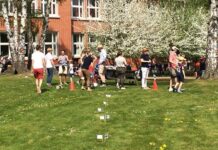During the course of the last 15 years or so several of the city’s neighbourhoods have changed dramatically. New businesses have sprung up, dilapidated buildings brought back to life and cool new cafes, restaurants and nightspots have suddenly appeared.
One of the people involved with this renaissance is Brussels entrepreneur Frederic Nicolay, who has the ability to spot the business potential of a run-down area. Take, for example, the St Gery part of Brussels, close to the Grand Place. So decrepit was it once upon a time that locals knew it as the area that was destroyed without a war.
Within the space of a couple of years, Nicolay opened three bars, Zebra, Mappa Mundo and the Roi des Belges, on Place St gery, and a handful of cafes. Fast forward to the present and St Gery is, arguably, one of the more lively parts of Brussels, although Nicolay sold the properties some time ago.
CREATIVITY
Barbara Debusschere, a 36-year-old journalist, sums up the feeling of many about Nicolay’s contribution to the development of urban life in Brussels, saying: “What he has achieved is quite remarkable. much of these areas were falling apart before he arrived on the scene. But, with his eye for creativity, he has really been at the forefront of the city’s revival.”
Talking about how he got involved in the renovation business, Nicolay explains: “During my studies at hotel school in Namur, I did a lot of student jobs during weekends, evenings, as a cook or server.
“In addition to compulsory courses, I often worked for caterers to prepare banquets for weddings and family celebrations. It was very intensive and I do not have very good memories. After school, I started working in starred restaurants but it did not feel right.”
After helping with the launch of Le Pain Quotidien, the brainchild of another Brussels entrepreneur, Alain Coumont, Nicolay opened his own restaurant in 1994.
“At Chez Marie I was serving and cooking. I had no money so I decorated the place by myself. I loved doing that. And people loved the place. That’s when I realized I did not like cooking and I preferred creating places for people.”
He decided to close Chez Marie, created yet another café, Bonsoir Clara, then sold it.
“It allowed me to clear all my debts and tackle new projects where i would not be in the kitchen. That’s the moment I started to do things on Place St Gery,” he recalls.
He is at pains to stress that he “creates” spaces. “I’m not a bartender or a manager. I’m an interior designer,” he says. “Sometimes I work for owners and sometimes I buy a place I like, I create it, and I sell it.”
NEW PROJECTS
Nicolay’s latest creations are Le Barbetonon Rue Dansaert, which he doesn’t own, and La Belle Equipe, that will soon open on the same street, which he does. “As soon as it is done, I’ll sell it to someone who wants to manage it.
”The location and renovation of Le Barbeton was by chance: “I learned by accident that the place was an old bar and was for rent. It is in a sunny spot and well placed, and I thought it would be nice to just rehabilitate the area.”
Aiming to offer “something for every taste” La Belle Equipe is a combination of cafe, pizzeria and wine bar.
“The decor and the concept are very different from what I have done before and different from what already exists,” he says.
Nicolay, 42, is also currently working on Flamingo, a cafe/bar due to open in May at the end of Rue de Laeken, close to the Flemish Theatre (KVS) and in the middle of a red light district.
“While some see this as a neighbourhood where prostitution is rife, I see it primarily as an opportunity,” he says. “After all, why go somewhere where there is everything – places like this are just waiting to be revived.”
All three venues are expected to soon feature among the must-visit hotspots in town.
Nicolay says his burning desire is to “bring friendliness to neighbourhoods that are not necessarily nice”.
He explains: “This does not mean restaurants and bars that are flashy places but places that may have a social use such as low-cost housing and cultural places.“
For me the challenge is to bring new and modern energy to areas that are poorly frequented. It takes a lot of energy and effort but with a little imagination and experience, everything becomes possible.”







